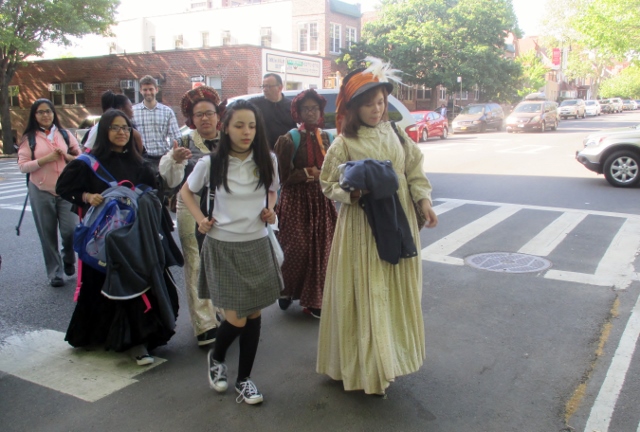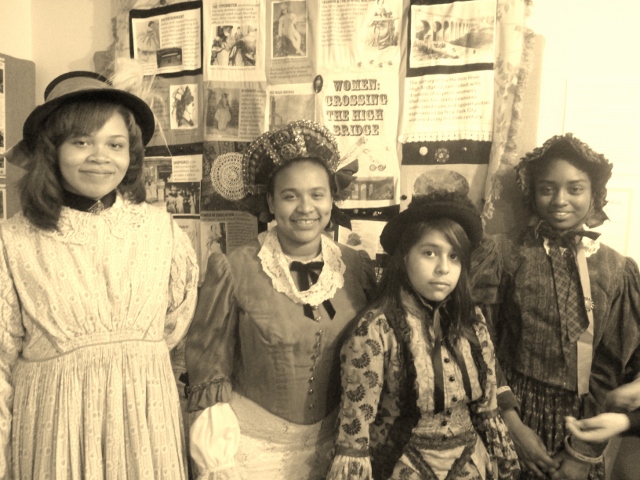
Photo by Jasmine Gomez
By JASMINE GOMEZ
Like characters out of a Jane Austen novel, several middle school girls from the Young Women’s Leadership Academy of the Bronx were decked in petticoats, corsets, and bonnets with smiles and stares from passers-by as they walked down Bainbridge Avenue. From there, the girls went back in time.
They were heading to the Bronx County Historical Society’s Museum of Bronx History at the Valentine-Varian House in Norwood, a trip that culminated their after school “Teen Thursdays” program. They dove into history by participating in a “High Tea” event, where they drank tea, ate cookies, and engaged in conversation while donning the typical costumes of women in the late 1800s.
“Teen Thursdays” is an initiative from the New York City Department of Education where schools can apply to participate and be partnered with cultural institutions across New York City. Each partnership allows students in grades 7 and 8 to learn American history through a hands-on curriculum that teaches students skills they can later apply in the actual classroom.

Photo by Jasmine Gomez
Sarah Reul and Matt Saccocio, both history teachers, said the initiative is intertwined with what’s happening at school–taking its historical lessons and applying it to the classroom, and vice versa.
This semester the girls focused on the building of the High Bridge, which is soon to re-open following a $65 million rehabilitation project, and how the building coincided with the generational changes women have experienced since the mid-19th century.
By sharpening their skills in research and the use of primary and secondary sources, the students created both a quilt and newspaper showcasing all the information they have learned throughout the semester.
“They did all the research themselves based on primary sources, primary documents at our housing society, pictures and documents that are part of our history and they are the actual reporters”, said Dimitris Raptopoulos, Director of Operations and Development for the Bronx County Historical Society.
Topics ranged from fashion in the 19th century compared to today’s current fashion trends, how the methods of fighting fires have evolved, and the juxtaposition of past and present diseases with an article entitled, “Is Yesterday’s Cholera Today’s Ebola?”
By having the students fill out actual job applications at the start of program as a learning activity, Janet Noquist-González, an educator of the program, models the curriculum to the individual interests of the students and to help them explore skills they may one day use when they enter the workforce.

Photo by Jasmine Gomez
The students also participated in field trips that included exploring the Highbridge neighborhood, a visit with a fashion consultant to explore the styles of different time periods, and a visit to the New York Botanical Garden, where they learned the roles of women in the evolution of the garden.
Many of the students were not only able to apply what they learned to the classroom, but to their personal lives as well. “Because of how I learned about how important it is for women to have a say and how important it is for them to pick who they want to be and who they want to marry, I took it to heart because now I want to get an education, I want to make something of myself because I know that before people couldn’t take advantage of [those] opportunities,” said Ysbely Santos, one of the students in the program.
Raptopoulos says he hopes to see the stature of Valentine-Varian House where the Museum of Bronx History is located become more integrated into the community because it is the “common history that binds us all.”
The school and museum’s dual partnership with the Young Women’s Leadership Academy is a step in the right direction, said Raptopoulos, hoping to see the Museum of Bronx History somehow integrated into New York’s education system.




